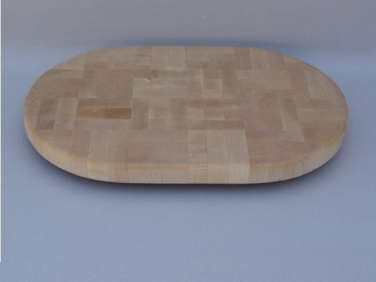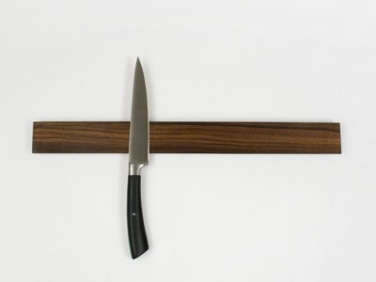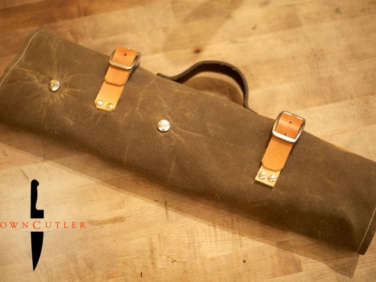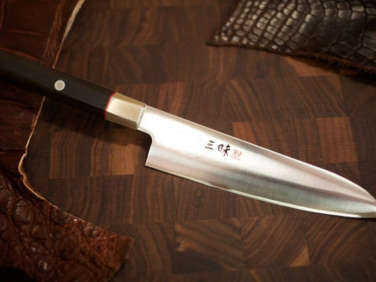When it comes to knives, there’s really only one place to go in San Francisco: Town Cutler. Many of the city’s famed chefs and serious foodies come to Galen Garretson’s store to keep their knives sharp and up to snuff. Garretson worked in several of the city’s restaurant kitchens as a butcher until he burned out and left to set up his own knife business a couple of years ago. I swung by his store the other day and asked him to tell me everything there is to know about knives.

Above: Galen Garretson at his Nob Hill shop, Town Cutler.
RM: What to look for when purchasing a knife?
GG: There are two classes of steel–carbon and stainless steel. Carbon oxidizes, can rust, and changes color with moisture while stainless always stays shiny. The most important thing with a knife is the heat-treating process. You can’t tell by looking, so that’s why you need to do research or come to people like us who pick steel that’s treated properly.
RM: How do you know which knife is right for you?
GG: A lot of knives are sold online, but you need to feel the weight of the knife and the balance; how it feels in the hand. You want all the weight to fall on the heel as it’s easier on the wrist and also better for balance and control.
RM: Which steel do you recommend?
GG: I prefer carbon, it’s the real deal. The grain strut has a finer edge than stainless and is easier to sharpen.

Above: A Wilburn Forge Knife.
RM: Your favorite carbon knife?
GG: Aaron Wilburn of Wilburn Forge in Redding, California, makes the best knives. He’s a Master Smith (one of 114 bestowed by the American Bladesmith Society). He’s taken techniques from Japanese hardening of steel and gone further to make the steel sharper and more durable. I like how sharp his knives are, the durability, how they cut, and how easy they are to sharpen. They’re expensive, but they’re the best.
RM: More affordable options?
GG: I like Zanmai from Japan. They use VG 10, a new stainless steel, and it’s the one I recommend. Shosui Takeda and Dietrich Podmajersky of Podforge from Seattle are also good.
Above: Gyuto Knife by Zanmai; $230.
RM: What are the essential knives to own in the kitchen?
GG: All you really need are the basics. I don’t believe in a full set of 12 knives. A good 8-inch all-purpose chef’s knife. A 5-to-6-inch utility for a second knife and a paring knife for handheld work.
Above: Knife Roll Case made by Town Cutler.
RM: Care for a knife?
GG: You need to keep it dry and keep it clean. Use dry warm soapy water after proteins and don’t use heavy abrasive wash. And never put your knives in the dishwasher. If the knife is carbon, the steel needs to be oiled often. It’s good to oil a stainless blade sometimes as it helps the edge.
RM: What oil do you recommend?
GG: We use a camellia oil and have one that we bottle here in the store.
Above: Magnetic Knife Bar by William Ullman; $95 from Canoe.
RM: Knife storage?
GG: Magnetic bars are the best because they keep the knives within easy reach. You can see them and they look good. Magnetic strip with non-exposed steel or magnets are best. There isn’t a current brand that I like, so I’m in the process of making my own out of cherry wood and rose wood. But those won’t be ready until the end of the year.
RM: Wood blocks for storage?
GG: No. You can ding the edge when you put the knife in a wood block–it’s not breathing in there–any moisture needs to evaporate.
RM: Tips on sharpening a knife?
GG: If you use one of those trucks which use a machine, the heat will the change the grain structure in the steel. Any belt sanding is to be avoided with knives. Use a water stone. It’s a type of stone lubricated by water, not oil. For basic sharpening, I recommend a three-step process. Starting with the coarser stone (Bester #1200) to create the bevel, then moving to a smoother stone (Arashiyama +6000) to polish the edge, then finishing on a leather strop, like you’d see in an old barber shop.
RM: Sharpening rods?
GG: A steel honing rod is for maintaining the edge, and it’sonly good for softer steel. It’s triage to give an edge a quick fix. Good for the likes of Henkels.
Above: An Oval Maple End Grain Up Cutting Board; $70 at Custom Made.
RM: What sort of cutting boards do you recommend?
GG: End-grain boards in hardwoods like maples and walnut; they’re hard, but not too hard. Plastic harvests bacteria, but wood has a lot more antibacterial qualities.
RM: What to avoid?
GG: Don’t use your knives for cutting bones and frozen foods. Avoid heat; with carbon knives, stay away from acidity.
RM: Pet peeve?
GG: People who bring in dirty, greasy knives for sharpening. Keep them clean.
See more insights from those in-the-know in our Expert Advice posts.
Frequently asked questions
Who is The Town Cutler?
The Town Cutler is a company founded by Galen Garretson, who is a master knife sharpener and former chef.
What is The Town Cutler known for?
The Town Cutler is known for its high-quality chef knives and personalized sharpening services.
What is the best type of steel for a chef knife?
The best type of steel for a chef knife is high carbon steel, as it holds a sharp edge better than other types of steel and allows for more control in cutting.
What is a honing rod?
A honing rod is a device used to straighten the edge of a knife between sharpenings, by realigning the microscopic teeth on the blade.
How often should you sharpen your knife?
This depends on how often you use your knife, but typically it's recommended to sharpen your knife every 3-6 months for home cooks and every 1-2 weeks for professional chefs.
How do you properly sharpen a knife?
To properly sharpen a knife, you should start with a coarse grit stone and gradually work your way up to a finer grit. Make sure to maintain a consistent angle while sharpening and to use a light touch.
What is the best way to store a chef knife?
The best way to store a chef knife is in a knife block or on a magnetic strip, as it prevents the blade from being damaged by other objects and allows for easy access.
How do you choose the right chef knife for you?
Choosing the right chef knife depends on personal preference and what type of cooking you usually do. It's recommended to try out different types and weights of knives before making a decision.













Have a Question or Comment About This Post?
Join the conversation